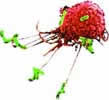|
The Design in the Cell

 THE
COMPLEXITY OF THE BRAIN CELL THE
COMPLEXITY OF THE BRAIN CELL
A brain cell is in constant interaction
with others numbering up to 10,000. This
communication network is far more complex
than all the switchboards in the world.
|
All living things are made
up of cells. Even a single cell is self-sufficient;
it can produce its own food, move, and communicate
with other cells. With its extraordinary technology,
the cell is concrete evidence that life cannot
originate by chance.
The cell, even a single protein
of which cannot form by chance, is a wonder of
design that renders the "chance" hypothesis
of evolution completely meaningless. In the cell,
there are power stations, complex factories, a
huge data bank, storage systems, and advanced
refineries.
 PLANT
CELL PLANT
CELL
In addition to human and animal cells,
the plant cell, too, is a miracle of creation.
The plant cell carries out a process that
no laboratory is able to perform today:
"photosynthesis." An organelle called
"chloroplast" in the plant cell enables
plants to produce starch by using water,
carbon dioxide, and sunlight. This substance
is the first link of the food chain on
the Earth and the food source of all living
things. The details of this highly complex
process are still unknown today.
|
In Darwin's time, nothing was
known about the extraordinary structure of the
cell. Under the primitive microscopes of the day,
the cell seemed to be a murky lump. For this reason,
both Darwin and other evolutionists of his time
believed that a cell was a simple driblet of water
that could easily originate by chance. The idea
that life could be attributed to chance gained
acceptance because of this primitive scientific
view.

An immunity cell capturing
the germs that have entered the body. |
The scientific developments
in the 20th century, however, revealed that the
cell has an unimaginably complex system. Today,
it is established that the cell, which has such
a complex design, could not possibly originate
by chance as the theory of evolution claims. It
is certain that a structure too complex to be
imitated even by man cannot be the work of "chance".
Renowned British mathematician and astronomer
Professor Fred Hoyle puts this impossibility like
this:
The chance that higher life
forms might have emerged in this way is comparable
with the chance that a tornado sweeping through
a junk-yard might assemble a Boeing 747 from the
materials therein.9
And in another commentary,
Hoyle says: "Indeed, such a theory (that
life was assembled by an intelligence) is so obvious
that one wonders why it is not widely accepted
as being self-evident. The reasons are psychological
rather than scientific."10
CAN AN AEROPLANE
FORM BY CHANCE?
  The
cell has such an intricate design that
renowned scientist Fred Hoyle (right)
compares it to a Boeing 747. According
to Hoyle, just as a plane cannot form
by chance, neither can a cell ever form
by chance. Actually, this example points
to an equally important truth: although
man is able to construct huge aircrafts
by the use of his knowledge and technology,
he has not yet been able to produce even
a single cell. The
cell has such an intricate design that
renowned scientist Fred Hoyle (right)
compares it to a Boeing 747. According
to Hoyle, just as a plane cannot form
by chance, neither can a cell ever form
by chance. Actually, this example points
to an equally important truth: although
man is able to construct huge aircrafts
by the use of his knowledge and technology,
he has not yet been able to produce even
a single cell.
|
| |
|
